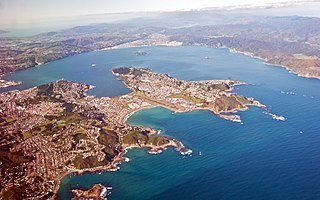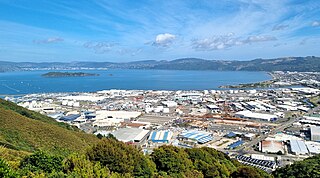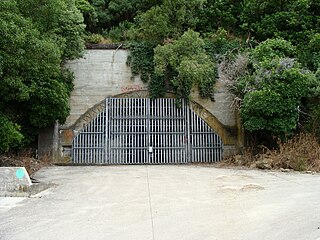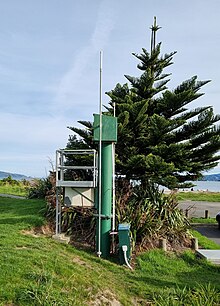
The Hutt Valley is the large area of fairly flat land in the Hutt River valley in the Wellington region of New Zealand. Like the river that flows through it, it takes its name from Sir William Hutt, a director of the New Zealand Company in early colonial New Zealand.

The Hutt River flows through the southern North Island of New Zealand. It flows south-west from the southern Tararua Range for 56 kilometres (35 mi), forming a number of fertile floodplains, including Kaitoke, central Upper Hutt and Lower Hutt.

Petone is a large suburb of Lower Hutt, Wellington. It stands at the southern end of the Hutt Valley, on the northern shore of Wellington Harbour.

Wellington Harbour, officially called Wellington Harbour / Port Nicholson, is a large natural harbour on the southern tip of New Zealand's North Island. The harbour entrance is from Cook Strait. Central Wellington is located on parts of the western and southern sides of the harbour, and the suburban area of Lower Hutt is to the north and east.

Matiu / Somes Island is the largest of three islands in the northern half of Wellington Harbour, New Zealand. The island is 24.9 hectares in area, and lies 3 kilometres south of the suburb of Petone and the mouth of the Hutt River.

Naenae is a suburb of Lower Hutt, New Zealand. It lies on the eastern edge of the floodplain of the Hutt River, four kilometres from the Lower Hutt Central business district. A small tributary of the Hutt, the Waiwhetū Stream, flows through the suburb. Naenae lies 19.7 km from Wellington Central.
Wellington Regional Council, branded as Greater Wellington Regional Council, is the regional council overseeing the Wellington Region of New Zealand's lower North Island. It is responsible for public transport under the brand Metlink, environmental and flood protection, and the region's water supply. As of 2023, it is the majority owner of CentrePort Wellington with a 77% shareholding.

The Hutt Valley Line is the electrified train service operated by Transdev Wellington on behalf of Metlink on the section of the Wairarapa Line railway between Wellington and Upper Hutt, New Zealand.

Hutt South is a parliamentary electorate in the lower Hutt Valley of New Zealand. It is held by Chris Bishop of the National Party following the 2023 election. It was previously held by Ginny Andersen of the Labour Party

Lower Hutt is a city in the Wellington Region of New Zealand. Administered by the Hutt City Council, it is one of the four cities that constitute the Wellington metropolitan area.
Fairfield is an eastern suburb of Lower Hutt, in the Wellington Region of New Zealand.

Belmont Regional Park is a regional park located between Lower Hutt and Porirua, in the Wellington Region at the southern end of New Zealand's North Island. It is administered by Wellington Regional Council. It was the first park in New Zealand to include land for recreation, conservation and farming.

Seaview is an industrial suburb of the city of Lower Hutt, in Wellington, New Zealand. Situated on the eastern coast of the Hutt Valley, the suburb lies between Te Awa Kairangi / the Hutt River and Petone, and the bays of Eastbourne to the south. Seaview is a centre for bulk liquid fuel storage for the lower half of the North Island, and a site for heavy industry. It is also a base for support services for trucks and transportation businesses and the location of the wastewater treatment plant for drainage from the Hutt Valley. Seaview is home to the Port Road Drags, the longest-running street drag races in Australasia.

Hōniana Te Puni was a Te Ati Awa leader and government member who played a significant role in the Wellington region in the early to mid 19th century.

The Wainuiomata Tunnel was planned to improve access to the Wainuiomata Valley in the Wellington region of New Zealand’s North Island as part of a scheme to commence residential development there in the 1930s. Construction started in 1932 but was halted a couple of years later when only partly completed due to a lack of funds brought about by economic depression.
Water supply and sanitation in the Wellington region involves the provision of the "three waters" – drinking water, stormwater, and wastewater services in the Greater Wellington region.

Water supply in the Wellington region involves the provision of drinking water services in the Greater Wellington region of New Zealand.

Point Howard is a suburb on the eastern side of Wellington Harbour, in Lower Hutt, New Zealand.

The Waiwhetū Stream is a small watercourse in Lower Hutt, in the North Island of New Zealand. The stream drains the eastern side of the Hutt Valley, and enters Wellington Harbour at the Hutt River estuary. Development and urbanisation of the Hutt Valley since the arrival of settlers led to increasing pollution and degradation of the stream environment. The stream was diverted into concrete culverts in some sections in an attempt to reduce flooding.

Wharves in Wellington Harbour have been essential to the operation of the Port of Wellington and to the development of the city and the lower half of the North Island of New Zealand.





















